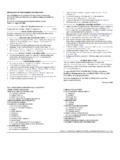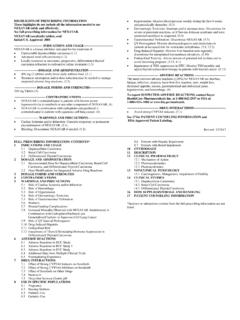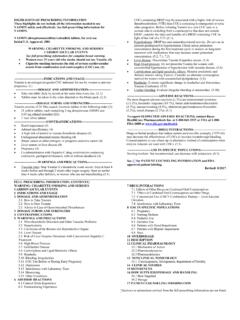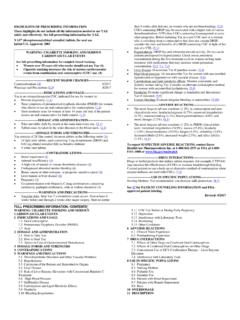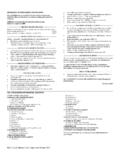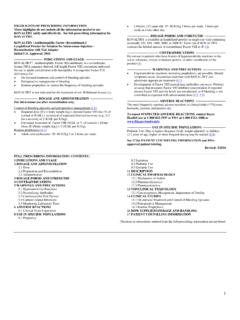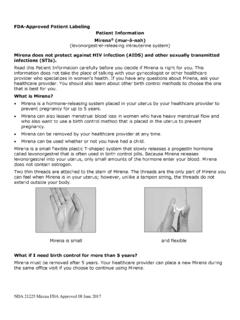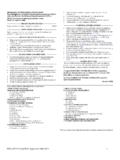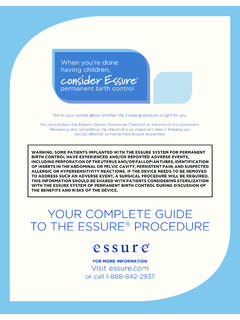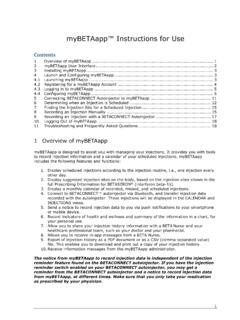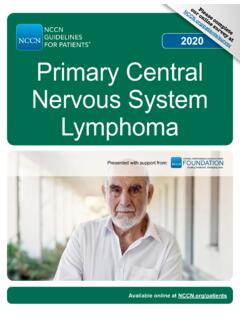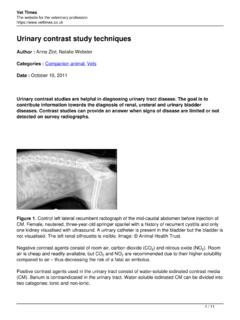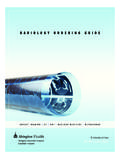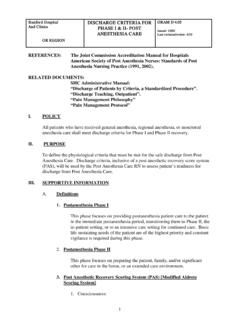Transcription of HIGHLIGHTS OF PRESCRIBING INFORMATION GADAVIST. …
1 HIGHLIGHTS OF PRESCRIBING INFORMATION These HIGHLIGHTS do not include all the INFORMATION needed to use GADAVIST safely and effectively. See full PRESCRIBING INFORMATION for GADAVIST. GADAVIST (gadobutrol) injection, for intravenous use Initial Approval: 2011 WARNING: NEPHROGENIC SYSTEMIC FIBROSIS (NSF) See full PRESCRIBING INFORMATION for complete boxed warning Gadolinium-based contrast agents (GBCAs) increase the risk for NSF among patients with impaired elimination of the drugs. Avoid use of GBCAs in these patients unless the diagnostic INFORMATION is essential and not available with non-contrasted MRI or other modalities. The risk for NSF appears highest among patients with: o Chronic, severe kidney disease (GFR < 30 mL/ ), or o Acute kidney injury.
2 Screen patients for acute kidney injury and other conditions that may reduce renal function. For patients at risk for chronically reduced renal function (for example, age >60 years, hypertension or diabetes), estimate the glomerular filtration rate (GFR) through laboratory testing. ( ). ----------------------------INDICATIONS AND USAGE--------------------------- Gadavist is a gadolinium-based contrast agent indicated for use with magnetic resonance imaging (MRI): To detect and visualize areas with disrupted blood brain barrier and/or abnormal vascularity of the central nervous system in adult and pediatric patients , including term neonates ( ) To assess the presence and extent of malignant breast disease in adult patients ( ) To evaluate known or suspected supra-aortic or renal artery disease in adult and pediatric patients , including term neonates ( ) To assess myocardial perfusion (stress, rest) and late gadolinium enhancement in adult patients with known or suspected coronary artery disease (CAD).
3 ( ). ----------------------DOSAGE AND ADMINISTRATION----------------------- Recommended dose for adults and pediatric patients (including term neonates) is mL/kg body weight ( ) Administer as an intravenous bolus injection ( ) Follow injection with a normal saline flush ( ) ---------------------DOSAGE FORMS AND STRENGTHS---------------------- Gadavist injection contains mg gadobutrol/mL (equivalent to 1 mmol gadobutrol/mL) and is available in vials and prefilled syringes ( 3) -------------------------------CONTRAIND ICATIONS------------------------------ History of severe hypersensitivity reaction to Gadavist (4) -----------------------WARNINGS AND PRECAUTIONS------------------------ Nephrogenic Systemic Fibrosis has occurred in patients with impaired elimination of GBCAs.
4 Higher than recommended dosing or repeated dosing appears to increase the risk. ( ) Anaphylactic and other hypersensitivity reactions with cardiovascular, respiratory or cutaneous manifestations, ranging from mild to severe, including death, have occurred. Monitor patients closely during and after administration of Gadavist. ( ) Gadolinium is retained for months or years in brain, bone, and other organs. ( ) --------------------------------ADVERSE REACTIONS----------------------------- Most common adverse reactions (incidence ) are headache, nausea, and dizziness ( ) To report SUSPECTED ADVERSE REACTIONS, contact Bayer HealthCare Pharmaceuticals Inc. at 1-888-842-2937 or FDA at 1-800-FDA-1088 or ------------------------USE IN SPECIFIC POPULATIONS---------------------- Pregnancy: Use only if imaging is essential during pregnancy and cannot be delayed.
5 ( ) See 17 for PATIENT COUNSELING INFORMATION and Medication Guide Revised: 4/20 22 full PRESCRIBING INFORMATION : CONTENTS* WARNING: NEPHROGENIC SYSTEMIC FIBROSIS 1 INDICATIONS AND USAGE Magnetic Resonance Imaging (MRI) of the Central Nervous System (CNS) MRI of the Breast Magnetic Resonance Angiography (MRA) Cardiac MRI 2 DOSAGE AND ADMINISTRATION Recommended Dose Administration Guidelines Drug Handling 3 DOSAGE FORMS AND STRENGTHS 4 CONTRAINDICATIONS 5 WARNINGS AND PRECAUTIONS Nephrogenic Systemic Fibrosis Hypersensitivity Reactions Gadolinium Retention 5. 4 Acute Kidney Injury 5. 5 Extravasation and Injection Site Reactions 5. 6 Overestimation of Extent of Malignant Disease in MRI of the Breast Low Sensitivity for Significant Arterial Stenosis 6 ADVERSE REACTIONS Clinical Trials Experience Postmarketing Experience 8 USE IN SPECIFIC POPULATIONS Pregnancy 8.
6 2 Lactation Pediatric Use Geriatric Use Renal Impairment 10 OVERDOSAGE 11 DESCRIPTION 12 CLINICAL PHARMACOLOGY Mechanism of Action Pharmacodynamics Pharmacokinetics 13 NONCLINICAL TOXICOLOGY Carcinogenesis, Mutagenesis, Impairment of Fertility Animal Toxicology and/or Pharmacology 14 CLINICAL STUDIES MRI of the CNS MRI of the Breast MRA Cardiac MRI 16 HOW SUPPLIED/STORAGE AND HANDLING How Supplied Storage and Handling 17 PATIENT COUNSELING INFORMATION *Sections or subsections omitted from the full PRESCRIBING INFORMATION are not listed full PRESCRIBING INFORMATION WARNING: NEPHROGENIC SYSTEMIC FIBROSIS (NSF) Gadolinium-based contrast agents (GBCAs) increase the risk for NSF among patients with impaired elimination of the drugs.
7 Avoid use of GBCAs in these patients unless the diagnostic INFORMATION is essential and not available with non-contrasted MRI or other modalities. NSF may result in fatal or debilitating fibrosis affecting the skin, muscle and internal organs. The risk for NSF appears highest among patients with: o Chronic, severe kidney disease (GFR < 30 mL/ ), or o Acute kidney injury. Screen patients for acute kidney injury and other conditions that may reduce renal function. For patients at risk for chronically reduced renal function (for example, age > 60 years, hypertension or diabetes), estimate the glomerular filtration rate (GFR) through laboratory testing. For patients at highest risk for NSF, do not exceed the recommended Gadavist dose and allow a sufficient period of time for elimination of the drug from the body prior to any re-administration [see Warnings and Precautions ( )].
8 1 INDICATIONS AND USAGE Magnetic Resonance Imaging (MRI) of the Central Nervous System (CNS) Gadavist is indicated for use with magnetic resonance imaging (MRI) in adult and pediatric patients , including term neonates, to detect and visualize areas with disrupted blood brain barrier and/or abnormal vascularity of the central nervous system. MRI of the Breast Gadavist is indicated for use with MRI in adult patients to assess the presence and extent of malignant breast disease. Magnetic Resonance Angiography (MRA) Gadavist is indicated for use in magnetic resonance angiography (MRA) in adult and pediatric patients , including term neonates, to evaluate known or suspected supra-aortic or renal artery disease.
9 Cardiac MRI Gadavist is indicated for use in cardiac MRI (CMRI) to assess myocardial perfusion (stress, rest) and late gadolinium enhancement in adult patients with known or suspected coronary artery disease (CAD). 2 DOSAGE AND ADMINISTRATION Recommended Dose The recommended dose of Gadavist for adult and pediatric patients (including term neonates) is mL/kg body weight ( mmol/kg). Refer to Table 1 to determine the volume to be administered. Table 1: Volume of Gadavist Injection by Body Weight* Body Weight (kg) Volume to be Administered (mL) 5 10 1 15 20 2 25 30 3 35 40 4 45 50 5 60 6 70 7 80 8 90 9 100 10 110 11 120 12 130 13 140 14 *for Cardiac MRI, the dose is divided into 2 separate, equal injections Administration Guidelines Gadavist is formulated at a higher concentration (1 mmol/mL) compared to certain other gadolinium based contrast agents, resulting in a lower volume of administration.
10 Use Table 1 to determine the volume to be administered. Use sterile technique when preparing and administering Gadavist. MRI of the Central Nervous System Administer Gadavist as an intravenous injection, manually or by power injector, at a flow rate of approximately 2 mL/second. Follow Gadavist injection with a normal saline flush to ensure complete administration of the contrast . Post contrast MRI can commence immediately following contrast administration. MRI of the Breast Administer Gadavist as an intravenous bolus by power injector, followed by a normal saline flush to ensure complete administration of the contrast . Start image acquisition following contrast administration and then repeat sequentially to determine peak intensity and wash-out.
